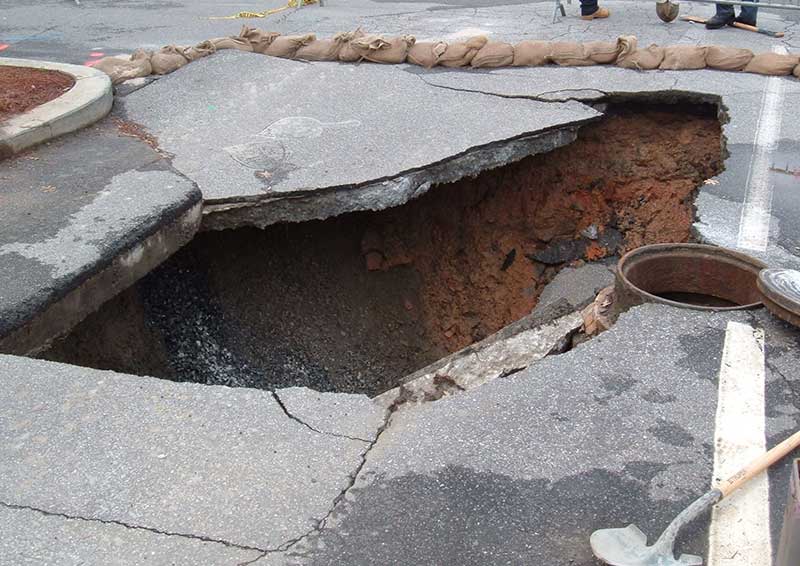Causes of sinkholes

|
| Sinkholes opening up in the middle of cities. |
A huge sinkhole swallowed a bus, killing six people in Northwest China in January 2020, sparking an electrical explosion and leaving several missing. Several people disappeared as the sinkhole spread and 16 people were taken to hospital.
Sinkholes are not uncommon in China and experts cite the country's rapid pace of huge construction work as one of the triggers.
Watch the BBC footage of the latest incident.
Dr. Clive Edmonds is a geotechnical specialist and has studied sinkholes for the past 30 years.
"The main trigger for sinkholes is water," says Dr. Edmonds. "In 90% of sinkhole cases, water saturating the mineral deposits is the main trigger, known as Karst processes.
"Sinkholes happen when a layer of rock underneath the ground is dissolved by water. In regards to China and their sites, I know there there are some Karst problems with limestone deposits.
"Sinkholes depend on geometry, some rocks are more soluble than others - salt deposits for instance dissolve more quickly. Gypsum for instance is a very soluble rock. Chalk and limestone deposits may take thousands of years to dissolve but when new cavities occur they can cause spectacular sinkholes."
"Human development can contribute greatly, especially construction work in urban areas where you may have dense development with roadworks, etc, as in the case of China. The surface becomes impermeable with water collecting over time in drains and sewers - water starts leaking into the ground."
"There are warning signs you can spot. First indicators are dips and depression in the ground surfaces, deepening with tiny cracks in pavements or buildings for instance, leading to buildings showing slight movement. "
Tunnelling into water filled cavities or where water bodies can flow catastrophically into an excavation are particularly hazardous.
"In the UK any such instances have been caused by small cracks in the ground leading to the onset of building movement and then a breakdown in the water utilities or leak of a mains water pipe or a sewer eventually draining water into the ground.
In the UK there has been a long history of mining and water abstraction, which in some areas has left a legacy of man-made cavities. The term sinkhole is, in the UK, often extended to cover the collapse of ground into such man-made features.
But predicting a sinkhole collapse is not easy as there can be very little surface evidence of the features.
Tony Bracegirdle is a senior partner of the Geotechnical Consulting Group.
"There are seldom warnings in urban areas," says Tony, "although sometimes sinkholes develop slowly to the extent that there is sufficient time to restrict access. Sinkholes tend to focus in specific geological and topographic conditions and so the hazard can be reasonably quantified in areas where there is a history of recurring sinkhole activity"
"The most common response in high-risk locations is to design works that are insensitive to potential sinkholes," says Tony, "to control surface water and to take additional precautions to limit water loss from drains and services."
What can civil engineers do to prevent sinkholes?
[edit] About this article
This article - written by ice.org.uk Andrew Panos of the Institution of Civil Engineers (ICE) - previously appeared on the ICE website in January 2020 under the title 'What are the causes of sinkholes'. It can be accessed HERE.
Other articles by the ICE on Designing Buildings Wiki can be accessed HERE.
[edit] Related articles on Designing Buildings Wiki
- Contingency plan.
- Design risk management.
- Health and safety.
- Interface risk in construction.
- Method statement.
- Near miss.
- Principles of prevention.
- Project risk.
- Retained risk.
- Risk assessments and method statements.
- Risk assessment.
- Risk feedback.
- Risk management.
- Risk register.
- Safety management.
- Surfside condo collapse: climate change demands adaptation in design and approach.
- Value management.
- What is a hazard?
Featured articles and news
Homes England supports Greencore Homes
42 new build affordable sustainable homes in Oxfordshire.
Zero carbon social housing: unlocking brownfield potential
Seven ZEDpod strategies for brownfield housing success.
CIOB report; a blueprint for SDGs and the built environment
Pairing the Sustainable Development Goals with projects.
Types, tests, standards and fires relating to external cladding
Brief descriptions with an extensive list of fires for review.
Latest Build UK Building Safety Regime explainer published
Key elements in one short, now updated document.
UKGBC launch the UK Climate Resilience Roadmap
First guidance of its kind on direct climate impacts for the built environment and how it can adapt.
CLC Health, Safety and Wellbeing Strategy 2025
Launched by the Minister for Industry to look at fatalities on site, improving mental health and other issues.
One of the most impressive Victorian architects. Book review.
Common Assessment Standard now with building safety
New CAS update now includes mandatory building safety questions.
RTPI leader to become new CIOB Chief Executive Officer
Dr Victoria Hills MRTPI, FICE to take over after Caroline Gumble’s departure.
Social and affordable housing, a long term plan for delivery
The “Delivering a Decade of Renewal for Social and Affordable Housing” strategy sets out future path.
A change to adoptive architecture
Effects of global weather warming on architectural detailing, material choice and human interaction.
The proposed publicly owned and backed subsidiary of Homes England, to facilitate new homes.
How big is the problem and what can we do to mitigate the effects?
Overheating guidance and tools for building designers
A number of cool guides to help with the heat.
The UK's Modern Industrial Strategy: A 10 year plan
Previous consultation criticism, current key elements and general support with some persisting reservations.
Building Safety Regulator reforms
New roles, new staff and a new fast track service pave the way for a single construction regulator.























